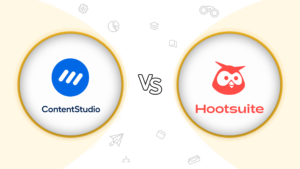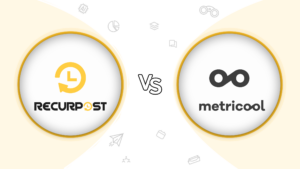Buffer vs Zoho Social
Zoho Social Vs Buffer- What’s Better in 2025?
Which tool is the best? Is it that hard to decide?
If you're stuck between Buffer and Zoho Social, you're not alone. Both offer great features, but the right choice depends on your needs.
No credit card required

Quick Summary: Buffer and Zoho Social
When deciding on the perfect social media management tool, certain aspects, such as features, pricing, reviews, and support, must be evaluated.
Here is the overview of tools:
2 months free with annual billing
Buffer Overview
Buffer stands as the veteran champion of social media scheduling, empowering over 180,000 creators, small businesses, and marketers to build consistent audiences across multiple platforms. With 194,011 active users publishing 7.8 million posts monthly across 11 supported social platforms, Buffer has established itself as the go-to solution for content creators and agencies alike.
The platform’s transparent approach extends beyond features, Buffer openly shares company metrics including their $22.9M annual recurring revenue, reflecting their commitment to honest business practices. Digital marketers value Buffer’s reliability and simplicity, making social media management accessible without overwhelming complexity or hidden costs.
Users value Buffer’s highly intuitive, user-friendly interface and effortless post scheduling, noting smooth workflows and dependable functionality. A few mentioned minor customer service hiccups, but still praised its solid value. [Capterra]
Reviewers describe Buffer as an intuitive, streamlined tool ideal for straightforward social scheduling. They appreciate its affordability, visual calendar, and coaching-style support, making it a reliable choice for managing multiple accounts. [G2]
Zoho Social Overview
Zoho Social brings the comprehensive power of the Zoho ecosystem to social media management, serving businesses worldwide with an intuitive platform trusted by over 90 million users globally. Part of Zoho’s broader business suite, this tool transforms complex social media workflows into streamlined operations that save time and amplify brand presence.
With 3,516 companies actively using Zoho Social in 2025 and recognition as a shortlisted platform for Social Engagement Platforms 2025, it delivers enterprise-grade capabilities wrapped in user-friendly design. Social media managers appreciate its seamless integration with CRM and customer service tools, making it ideal for businesses seeking unified digital operations.
Users praise Zoho Social for its seamless, intuitive interface, smooth scheduling, multi-account handling, strong analytics, and excellent ease of use, many report zero complaints and high satisfaction with value and integration. [Capterra]
Reviewers call Zoho Social “incredibly easy to use,” highlighting its clean interface, visual calendar, team collaboration, cross-platform publishing, time savings, and solid analytics, with only minor mobile app speed concerns. [G2]
Rating Comparison
Feature Comparison: Buffer vs Zoho Social
Features
Scheduling & Publishing
Queue-based scheduler with calendar view; supports Threads, Mastodon, Instagram, TikTok, and more.
Smart scheduling, bulk uploads, and calendar view with platform-specific post previews and time slot suggestions.
AI-powered scheduler recycles evergreen content, auto-schedules posts, and suggests best times to publish.
Engagement
Simple engagement inbox for replying to Instagram and Facebook comments and messages.
Unified inbox for replying to comments, messages, and mentions across platforms in real time.
Unified inbox helps reply faster; smart filters prioritize conversations that need attention.
Collaboration
Team permissions, post approvals, and shared calendars streamline small-team collaboration.
Approval workflows, role-based permissions, and client portals for agency collaboration and feedback.
Shared workspaces and approval flows keep teams aligned with role-based access and smart task routing.
Analytics
Track clicks, reach, engagement, and best-performing posts with exportable reports.
Approval workflows, role-based permissions, and client portals for agency collaboration and feedback.
Smart analytics track engagement, reach, and clicks; white-label reports simplify client performance tracking.
AI Features
AI Assistant writes captions, suggests hashtags, and improves post tone and clarity.
AI-powered SmartQ predicts best posting times; automated content suggestions improve consistency and engagement.
Generates captions, hashtags, bios, and post ideas; predicts performance; automates scheduling and reports.
Pros & Cons: Buffer and Zoho Social
Pros
- Great value in the paid version for scheduling more posts
- Helpful and quick customer service
Cons
- Feature loss with some software upgrades
- The app may freeze or fail to post during low connectivity
Pros
- A clear navigation that works well for beginners.
- Provides detailed analytics and reporting
Cons
- Users report slow response times and unhelpful answers from support team
- Poor handling of videos and images
Pricing Comparison
Essentials
5 Social channel, 1 User, Unlimited ideas
Standard
1 user, No cross brand publishing, No youtube shorts
Starter
2 social profiles, 10 daily posts, 5 recurring time slots
Team
5 Social channel, Unlimited users, Content approval workflows
Professional
1 user, Cross brand publishing, No social inbox
Personal
5 social profiles, 20 daily posts, 10 recurring time slots
Premium
Advance analytics, AI assistant, Approval workflow, Monitoring
Agency
20 social profiles, 80 daily posts, 40 recurring time slots
Why RecurPost Stands Out
RecurPost can be the perfect Buffer and Zoho Social alternative for businesses looking to streamline content management. When you compare Buffer vs Zoho Social, RecurPost revolutionizes social media automation for over 100,000 businesses across 163+ countries, delivering intelligent scheduling that drives 11–18% more impressions compared to manual posting. This powerful platform has already facilitated 60+ million posts and generated 130+ million user engagements, proving its effectiveness in real-world applications.
Unlike many tools, RecurPost stands out with advanced automation that detects and fixes 850+ post-breaking glitches such as expired tokens and API issues. This ensures your campaigns run smoothly while you focus on strategy. With 32% higher engagement through optimized posting times and white-label reporting, RecurPost transforms social media from a time-consuming task into a growth-driving asset.
When it comes to costs, Buffer and Zoho Social can be pretty expensive. Buffer’s social media tool charges $12 per channel, totaling $60 for five channels, whereas RecurPost offers the same five channels for just $25. Zoho Social does provide a free plan, but it lacks long-term scalability for growing businesses.
The platform’s intuitive design ensures a user-friendly experience for both beginners and pros. With features like shared calendars for client collaboration, seasonal libraries for time-bound campaigns, and Instagram DM automation, RecurPost makes content management effortless. Combined with its two-tier validation system for posting reliability, it’s clear why RecurPost consistently earns praise over other tools.
Why RecurPost is better!
RecurPost isn’t just an alternative to Buffer and Zoho Social – it’s a smarter choice for businesses that want more functionality at a lower cost.






